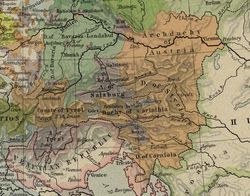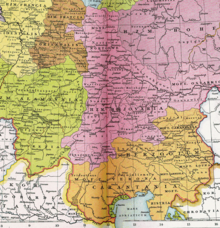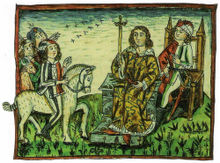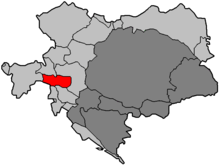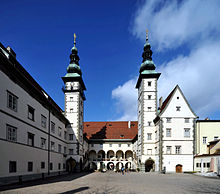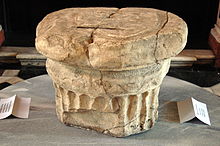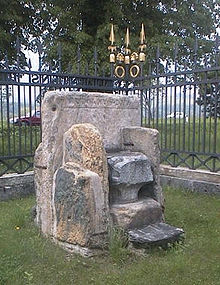- Duchy of Carinthia
-
Duchy of Carinthia
Herzogtum Kärnten (de)
Vojvodina Koroška (sl)State of the Holy Roman Empire (until 1806),
constituent land of the Austrian Empire and
Cisleithanian crown land of Austria-Hungary← 
976–1919  →
→
 →
→
 →
→

Flag Coat of arms Habsburg hereditary lands in 1477 Capital Sankt Veit an der Glan (Šentvid ob Glini) until 1518, then Klagenfurt (Celovec) Government Principality Historical era Middle Ages - Created Duchy 976 - Bequeathed to
House of Habsburg1335 - Joined Austrian Circle 1512 - Upper Carinthia
ceded to
Illyrian Provinces
1809- Restored to Austria 1815 - Partitioned by
Treaty of St Germain1919 Today part of  Austria
Austria
 Italy
Italy
 Slovenia
SloveniaThe Duchy of Carinthia (German: Herzogtum Kärnten; Slovene: Vojvodina Koroška) was a duchy located in southern Austria and parts of northern Slovenia. It was separated from the Duchy of Bavaria in 976, then the first newly created Imperial State beside the original German stem duchies.
Carinthia remained a part of the Holy Roman Empire until its dissolution in 1806, and a crownland of Austria-Hungary until 1918. By the 1919 Treaty of Saint-Germain the main area of the duchy formed the Austrian state of Carinthia, a small southeastern part (the present-day region of Slovenian Carinthia) was included into the newly created Kingdom of Serbs, Croats and Slovenes, while the southwestern Canal Valley (Val Canale) was ceded to the Kingdom of Italy.
Contents
Carantania and medieval dynasties
In the 7th century the area was part of the Slavic principality of Carantania, which about 743 fell under the suzerainty of Duke Odilo of Bavaria. The Bavarian stem duchy was finally incorporated into the Carolingian Empire, when Charlemagne deposed Odilo's son Duke Tassilo III in 788. In the course of the 843 partition by the Treaty of Verdun, Carinthia became part of East Francia under King Louis the German. From 889 to 976 it was the Carinthian March of the renewed Bavarian duchy, though in 927 the local Count Berthold of the Luitpolding dynasty was already vested with ducal rights by the German king Henry the Fowler. After Berthold became Duke of Bavaria in 938, both territories were ruled by him. Upon his death in 948 the Luitpoldings, though dedicated liensmen of the royal Ottonian dynasty, were not able to retain their possessions, as King Otto I enfeoffed his younger brother Henry I with the Bavarian lands.
Duke Henry's son Henry II "the Quarreller" however from 974 on revolted against his cousin Emperor Otto II, whereafter he was deposed as Duke of Bavaria in favour of Otto's nephew Duke Otto I of Swabia. At the same time Emperor Otto II took the occasion to create a sixth duchy beside the original stem duchies, the new Duchy of Carinthia. He reverted to the Luitpoldings, when he split Carinthia off the Bavarian lands and invested the former Duke Berthold's son Henry III the Younger as duke in 976. The duchy then comprised a vast territory including the marches of Styria (marchia Carantana), Carniola and Istria as well as the March of Verona in the former Kingdom of Italy. Nevertheless Henry III was the first and also the last Luitpolding duke: as he chose to join the unsuccessful War of the Three Henries against Emperor Otto II, he lost Carinthia two years later and was succeeded by the Emperor's nephew Otto I, a scion of the Salian dynasty. Though Henry III once again managed to regain the ducal title in 985, Carinthia upon his death in 989 fell back to the Imperial Ottonian dynasty of Bavaria.
Carinthia however remained a separate entity, and in 1012 Count Adalbero I of Eppenstein, Margrave of Styria since about 1000, was vested with the duchy by Emperor Henry II, while the Istrian march was separated and given to Count Poppo of Weimar. Adalbero was removed from office in 1035 after he had fallen out of favour with the Salian Emperor Conrad II. In 1039 Carinthia was inherited by Emperor Henry III himself, who finally split off the Carniolian march the next year and also granted it to Margrave Poppo of Istria. In 1077, the duchy was given to Luitpold, again a member of the Eppensteiner family, which, however, became extinct with the death of Luitpold's son Henry III of Carinthia in 1122. Upon his death the duchy was further reduced in area: a large part of the Eppenstein lands in what is today Upper Styria passed to Margrave Ottokar II of Styria.
The remainder of Carinthia passed from Duke Henry III to his godchild Henry from the House of Sponheim, who as Henry IV ruled from 1122 to his early death the following year.[1] The most outstanding of the Spanheim dukes was Bernhard, the first Carinthian duke who was actually described and honoured in documents as "prince of the land".[1] The last Spanheim duke was Ulrich III; he at first signed an inheritance treaty with his brother Archbishop Philipp of Salzburg, who however could not prevail against the Bohemian king Ottokar II Přemysl. In spite of being supported by the German king Rudolph of Habsburg, who defeated Ottokar II at the 1278 Battle on the Marchfeld, Philipp never gained actual power. The duchy was seized by Rudolph, Philipp died in 1279.
Habsburgs
Rudolph, after being elected King of the Romans and defeating King Ottokar II, at first gave Carinthia to Count Meinhard II of Gorizia-Tyrol. In 1335, after the death of Henry, the last male of this line, Emperor Louis the Bavarian finally gave Carinthia and the southern part of the Tyrol as an imperial fief on May 2, 1335 in Linz to the Habsburg family, who ruled it until 1918. As the other component parts of the Habsburg Monarchy, Carinthia remained a semi-autonomous state with its own constitutional structure for a long time. The Habsburgs divided up their territories within the family twice, according to the 1379 Treaty of Neuberg and again in 1564. Each time, the Duchy of Carinthia became part of Inner Austria and was ruled jointly with the adjacent duchies of Styria and Carniola.
Empress Maria Theresa of Austria and her son Joseph II attempted to create a more unitary Habsburg state, and in 1804, Carinthia was integrated into the Austrian Empire. According to the 1809 Treaty of Schönbrunn, the Upper Carinthian territories around Villach formed part of the short-lived Napoleonic Illyrian Provinces; Carinthia as a whole remained a part of the Habsburg Kingdom of Illyria until its dissolution in 1849. In 1867, the duchy became a crown land of Cisleithania, the western part of Austria-Hungary (see History of Austria).
Over the centuries, German, which carried more prestige, expanded at the expense of Slovene, but the fact that in the 16th century the Estates of Carinthia could still point out that Carinthia was "a Windic Archduchy", i.e. a sovereign Slovene principality, shows that the Carinthian people were aware of their ancient and pre-German roots.
20th century
During the First World War, Carinthia experienced a relatively high number of war deaths - thirty-seven for every 1,000 inhabitants. This was higher than in most other German speaking areas of Austria-Hungary (except German South Moravia).[2]
Following the end of World War I and the dissolution of Austria-Hungary, the 1919 Treaty of Saint-Germain stipulated the Carinthian Canal Valley stretching from Tarvisio as far as Pontafel (172 square miles)[3] go to Italy and that the Slovene-speaking areas of the Meža Valley, the Drava Valley area around Unterdrauburg, which was afterwards renamed Dravograd, and the Jezersko area (128 square miles of territory) [3] be ceded to the new SHS-State. The Kingdom of Serbs, Croats and Slovenes, however, was not satisfied with these parts of the former duchy and also occupied land north of the Karawanken mountain range, including the capital city of Klagenfurt. The Entente powers decided on a two-stage referendum, of which the first stage, the Carinthian Plebiscite was held on October 10, 1920 to determine the fate of Carinthia. The outcome in favour of Austria did not change the borders as decided upon in the Treaty of Saint-Germain.
The Austrian part of the former duchy today forms the federal state of Carinthia (German: Land Kärnten), while the area that was ceded to Italy as a part of the claimed "Julian March", belongs to the autonomous region of Friuli–Venezia Giulia. Most of the area that had fallen to Yugoslavia (cf. Slovenian Carinthia) now forms part of the larger Koroška statistical region in Slovenia.
Area and population
Area:
- Total: 10,327 km²
Population (1910 Census):
- Total (estimate): 396,200
Linguistic composition
According to the last Austrian Imperial census of 1910, the Duchy of Carinthia was composed of the following linguistic communities:
Total (estimate): 396,200
- German: 304,287 (76.80 %)
- Slovene: 82,212 (20.75 %)
- Italian: 82 (0.02 %)
- Other languages or unknown: 9,619 (2.43 %)
The Austrian censuses did not count ethnic groups, nor the mother tongue, but the "language of daily interaction" (Umgangssprache).
Religious composition
Total (estimate): 396,200
- Roman Catholics: 385,314 (97.25 %)
- Protestants: 9,698 (2.45 %)
- Jewish: 396 (0.10 %)
- Other religions or unknown: 792 (0.20 %)
Dukes of Carinthia
Various dynasties
Luitpoldings
- Henry I (976-978)
- Otto I (978-985)
Luitpoldings
- Henry I (985-989), again, Duke of Bavaria 983-985
- Henry II (989-995), also Duke of Bavaria 985-995
- Henry III (995-1002), also Duke of Bavaria 995-1005
- Otto I (1002–1004), again
- Conrad I (1004–1011)
- Adalbero (1011–1035)
- Conrad II (1036–1039)
- Henry IV (1039–1047), also Duke of Bavaria 1026-1041 and Holy Roman Emperor (as Henry III) 1046-1056
- Welf (1047–1055)
- Conrad III (1056–1061)
- Berthold II (1061–1077)
- Luitpold (1077–1090)
- Henry V (1090–1122)
House of Sponheim
- Henry IV (1122–1123 )
- Engelbert (1123–1134)
- Ulrich I (1134–1144)
- Henry V (1144–1161)
- Herman II (1161–1181)
- Ulrich II (1181–1201)
- Bernhard (regent from 1199, duke 1202-1256)
- Ulrich III (1256–1269)
Various dynasties
- Otakar (1269–1276), also King of Bohemia 1253-1278
- Rudolph I (1276–1286), also King of Germany 1273-1291
Gorizia-Tyrol
- Meinhard (1286–1295)
- Henry VI (1295–1335), also King of Bohemia 1306/1307-1310, jointly with his brothers
- Louis (1295–1305)
- Otto III (1295–1310)
House of Habsburg
- Otto IV (1335–1339), jointly with his brother
- Albert II (1335–1358)
- Frederick (1358–1362), jointly with his brother
- Rudolph II (1358–1365)
- Albert III (1365–1395)
Leopoldian line
-
- Leopold (1379–1386)
- William (1386–1406)
- Ernest (1406–1424)
- Frederick (1424–1493)
Habsburg territories reunified in 1458
- Maximilian I (1493–1519), also Holy Roman Emperor 1508-1519
- Charles I (1519–1521), also Holy Roman Emperor 1519-1556
- Ferdinand I (1521–1564), also Holy Roman Emperor 1558-1564
Inner Austrian Habsburgs
- Charles II (1564–1590)
- Ferdinand II (1590–1637), also Holy Roman Emperor 1619-1637
Carinthia was unified with the rest of the Habsburg territories again in 1619. See List of rulers of Austria
Notes and references
- ^ a b Mediaeval Genealogy
- ^ Rothenburg, G. The Army of Francis Joseph. West Lafayette: Purdue University Press, 1976. p 218.
- ^ a b ”Kärnten.” Encyclopædia Britannica. Ultimate Reference Suite. Chicago 2010.
See also
- Carantania
- Carantanians
- Carinthian Slovenes
- History of Austria
- History of Slovenia
- Black panther (symbol)
External links
 Austrian Circle of the Holy Roman Empire
Austrian Circle of the Holy Roman Empire Habsburg lands
Habsburg lands
Prince-Bishoprics  Teutonic bailiwicksAn der Etsch · Austria
Teutonic bailiwicksAn der Etsch · AustriaProvinces of the Austrian Empire Kingdom of Bohemia · Kingdom of Hungary · Kingdom of Illyria · Kingdom of Dalmatia · Kingdom of Croatia-Slavonia · Kingdom of Galicia and Lodomeria · Kingdom of Lombardy and Venetia · Archduchy of Austria · Duchy of Carinthia · Duchy of Carniola · Duchy of Salzburg · Duchy of Upper and Lower Silesia · Duchy of Styria · Duchy of Bukovina · Voivodeship of Serbia and Banat of Temeschwar · Grand Principality of Transylvania · Margraviate of Moravia · Princely County of Tyrol with Vorarlberg · Austrian Littoral (Princely County of Gorizia and Gradisca · Margravate of Istria · Imperial Free City of Trieste) · Military Frontier
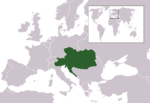 Categories:
Categories:- Former principalities
- Former countries in Europe
- States of the Holy Roman Empire
- States and territories established in 976
- States and territories disestablished in 1919
- 1919 disestablishments
- Carinthia
- Dukes of Carinthia
- States of the German Confederation
- Austrian Circle
- Historical regions in Austria
- Historical regions in Slovenia
- Former Slavic countries
Wikimedia Foundation. 2010.

